Back-Roads Touring: Tourism Consumer Behaviour and Insight Report
VerifiedAdded on 2023/01/04
|14
|4134
|53
Report
AI Summary
This report provides a comprehensive analysis of tourism consumer behaviour, examining the psychological, personal, social, and cultural factors that influence consumer decisions. It explores the impact of digital technology on consumer trends, including the use of smartphones and augmented reality. The report details the stages of the consumer decision-making journey, emphasizing the importance of mapping the path to purchase to understand customer needs and enhance the overall experience. It also differentiates between B2C and B2B decision-making processes in the hospitality sector and discusses market research approaches used to understand consumer behaviour. Furthermore, it analyzes the influence of marketing strategies on the various stages of the tourism decision-making process, offering insights for businesses like Back-Roads Touring to improve their marketing tactics and customer satisfaction. The report highlights the significance of personalization and efficient marketing strategies in the competitive tourism market.
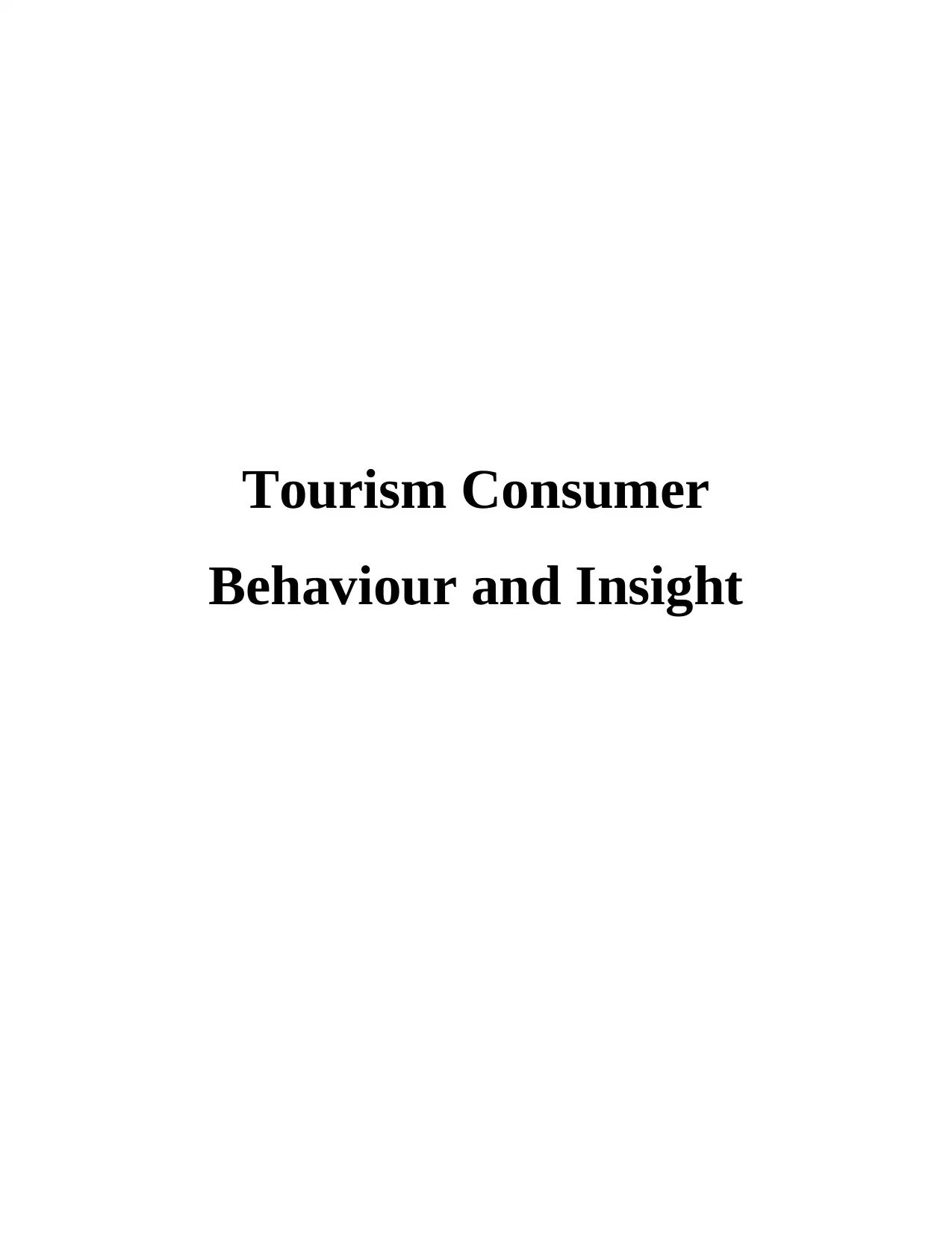
Tourism Consumer
Behaviour and Insight
Behaviour and Insight
Paraphrase This Document
Need a fresh take? Get an instant paraphrase of this document with our AI Paraphraser
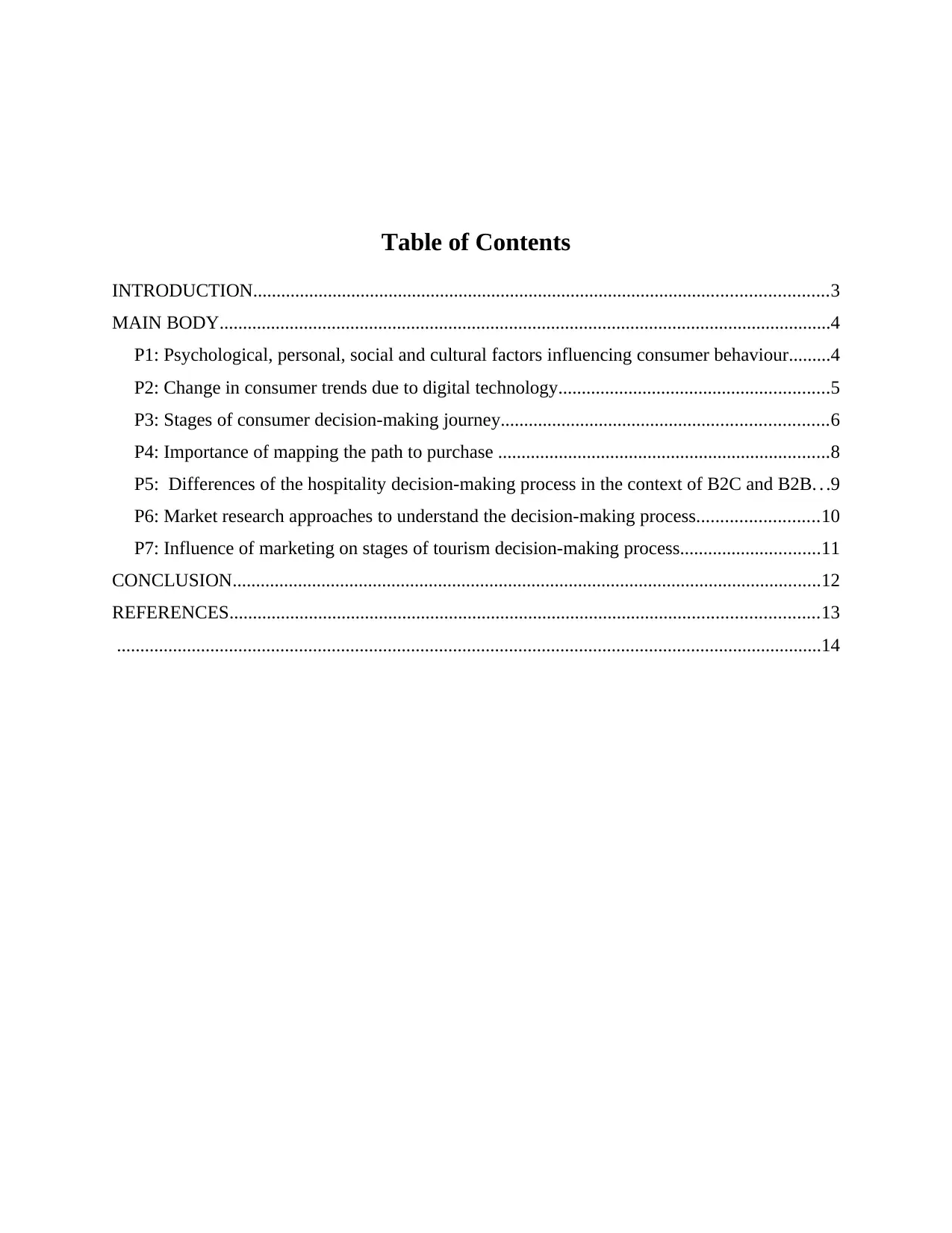
Table of Contents
INTRODUCTION...........................................................................................................................3
MAIN BODY...................................................................................................................................4
P1: Psychological, personal, social and cultural factors influencing consumer behaviour.........4
P2: Change in consumer trends due to digital technology..........................................................5
P3: Stages of consumer decision-making journey......................................................................6
P4: Importance of mapping the path to purchase .......................................................................8
P5: Differences of the hospitality decision-making process in the context of B2C and B2B. . .9
P6: Market research approaches to understand the decision-making process..........................10
P7: Influence of marketing on stages of tourism decision-making process..............................11
CONCLUSION..............................................................................................................................12
REFERENCES..............................................................................................................................13
.......................................................................................................................................................14
INTRODUCTION...........................................................................................................................3
MAIN BODY...................................................................................................................................4
P1: Psychological, personal, social and cultural factors influencing consumer behaviour.........4
P2: Change in consumer trends due to digital technology..........................................................5
P3: Stages of consumer decision-making journey......................................................................6
P4: Importance of mapping the path to purchase .......................................................................8
P5: Differences of the hospitality decision-making process in the context of B2C and B2B. . .9
P6: Market research approaches to understand the decision-making process..........................10
P7: Influence of marketing on stages of tourism decision-making process..............................11
CONCLUSION..............................................................................................................................12
REFERENCES..............................................................................................................................13
.......................................................................................................................................................14
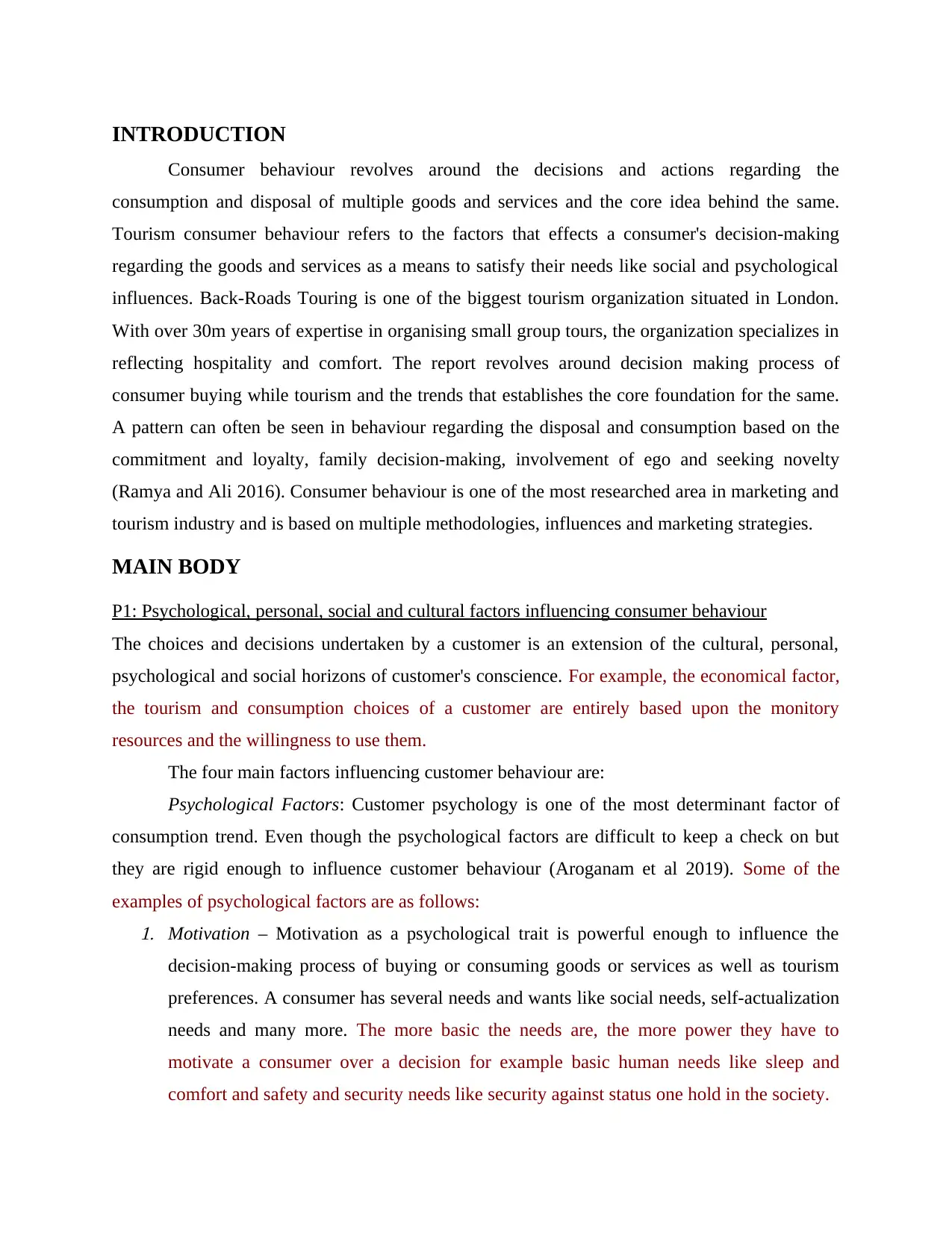
INTRODUCTION
Consumer behaviour revolves around the decisions and actions regarding the
consumption and disposal of multiple goods and services and the core idea behind the same.
Tourism consumer behaviour refers to the factors that effects a consumer's decision-making
regarding the goods and services as a means to satisfy their needs like social and psychological
influences. Back-Roads Touring is one of the biggest tourism organization situated in London.
With over 30m years of expertise in organising small group tours, the organization specializes in
reflecting hospitality and comfort. The report revolves around decision making process of
consumer buying while tourism and the trends that establishes the core foundation for the same.
A pattern can often be seen in behaviour regarding the disposal and consumption based on the
commitment and loyalty, family decision-making, involvement of ego and seeking novelty
(Ramya and Ali 2016). Consumer behaviour is one of the most researched area in marketing and
tourism industry and is based on multiple methodologies, influences and marketing strategies.
MAIN BODY
P1: Psychological, personal, social and cultural factors influencing consumer behaviour
The choices and decisions undertaken by a customer is an extension of the cultural, personal,
psychological and social horizons of customer's conscience. For example, the economical factor,
the tourism and consumption choices of a customer are entirely based upon the monitory
resources and the willingness to use them.
The four main factors influencing customer behaviour are:
Psychological Factors: Customer psychology is one of the most determinant factor of
consumption trend. Even though the psychological factors are difficult to keep a check on but
they are rigid enough to influence customer behaviour (Aroganam et al 2019). Some of the
examples of psychological factors are as follows:1. Motivation – Motivation as a psychological trait is powerful enough to influence the
decision-making process of buying or consuming goods or services as well as tourism
preferences. A consumer has several needs and wants like social needs, self-actualization
needs and many more. The more basic the needs are, the more power they have to
motivate a consumer over a decision for example basic human needs like sleep and
comfort and safety and security needs like security against status one hold in the society.
Consumer behaviour revolves around the decisions and actions regarding the
consumption and disposal of multiple goods and services and the core idea behind the same.
Tourism consumer behaviour refers to the factors that effects a consumer's decision-making
regarding the goods and services as a means to satisfy their needs like social and psychological
influences. Back-Roads Touring is one of the biggest tourism organization situated in London.
With over 30m years of expertise in organising small group tours, the organization specializes in
reflecting hospitality and comfort. The report revolves around decision making process of
consumer buying while tourism and the trends that establishes the core foundation for the same.
A pattern can often be seen in behaviour regarding the disposal and consumption based on the
commitment and loyalty, family decision-making, involvement of ego and seeking novelty
(Ramya and Ali 2016). Consumer behaviour is one of the most researched area in marketing and
tourism industry and is based on multiple methodologies, influences and marketing strategies.
MAIN BODY
P1: Psychological, personal, social and cultural factors influencing consumer behaviour
The choices and decisions undertaken by a customer is an extension of the cultural, personal,
psychological and social horizons of customer's conscience. For example, the economical factor,
the tourism and consumption choices of a customer are entirely based upon the monitory
resources and the willingness to use them.
The four main factors influencing customer behaviour are:
Psychological Factors: Customer psychology is one of the most determinant factor of
consumption trend. Even though the psychological factors are difficult to keep a check on but
they are rigid enough to influence customer behaviour (Aroganam et al 2019). Some of the
examples of psychological factors are as follows:1. Motivation – Motivation as a psychological trait is powerful enough to influence the
decision-making process of buying or consuming goods or services as well as tourism
preferences. A consumer has several needs and wants like social needs, self-actualization
needs and many more. The more basic the needs are, the more power they have to
motivate a consumer over a decision for example basic human needs like sleep and
comfort and safety and security needs like security against status one hold in the society.
⊘ This is a preview!⊘
Do you want full access?
Subscribe today to unlock all pages.

Trusted by 1+ million students worldwide
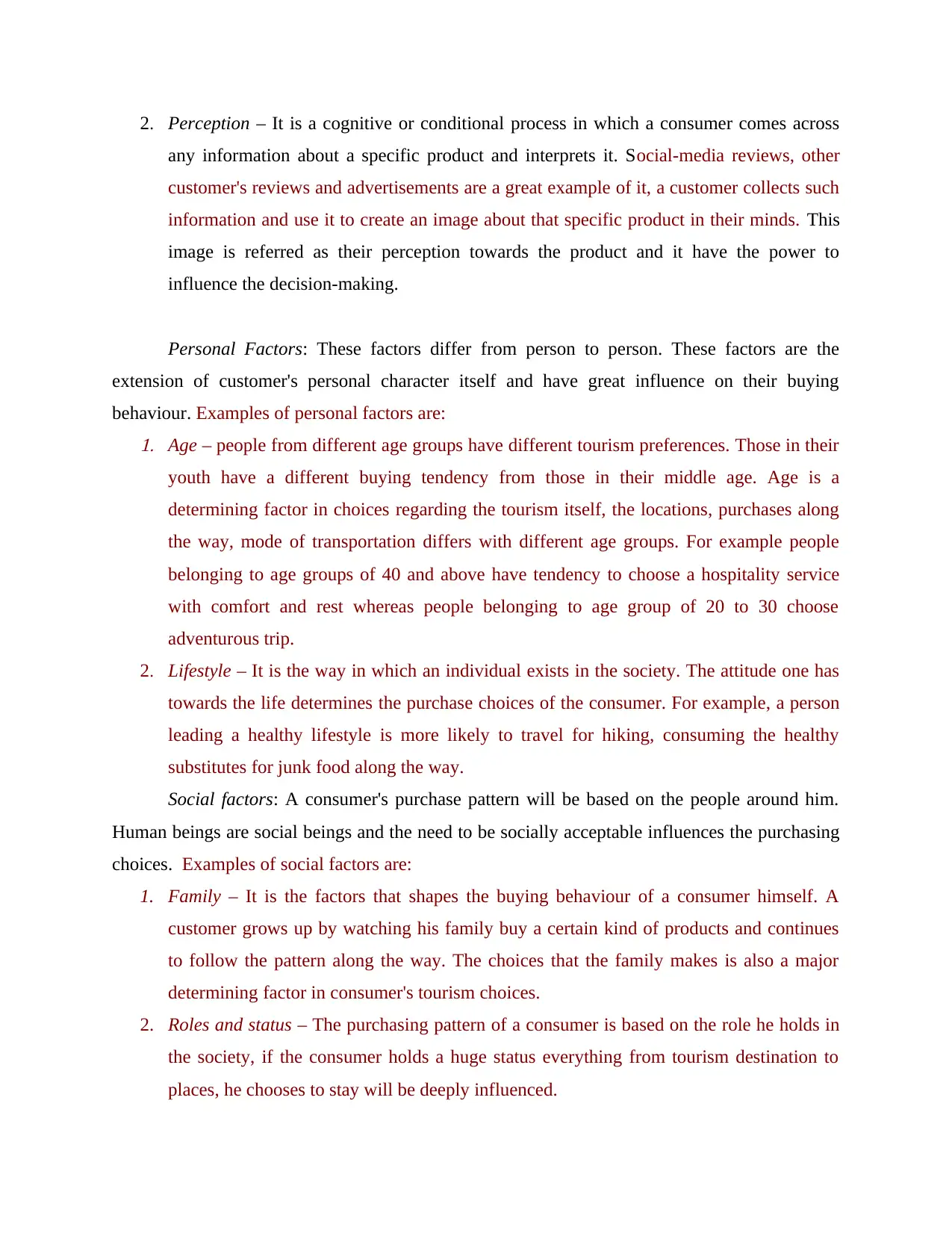
2. Perception – It is a cognitive or conditional process in which a consumer comes across
any information about a specific product and interprets it. Social-media reviews, other
customer's reviews and advertisements are a great example of it, a customer collects such
information and use it to create an image about that specific product in their minds. This
image is referred as their perception towards the product and it have the power to
influence the decision-making.
Personal Factors: These factors differ from person to person. These factors are the
extension of customer's personal character itself and have great influence on their buying
behaviour. Examples of personal factors are:1. Age – people from different age groups have different tourism preferences. Those in their
youth have a different buying tendency from those in their middle age. Age is a
determining factor in choices regarding the tourism itself, the locations, purchases along
the way, mode of transportation differs with different age groups. For example people
belonging to age groups of 40 and above have tendency to choose a hospitality service
with comfort and rest whereas people belonging to age group of 20 to 30 choose
adventurous trip.
2. Lifestyle – It is the way in which an individual exists in the society. The attitude one has
towards the life determines the purchase choices of the consumer. For example, a person
leading a healthy lifestyle is more likely to travel for hiking, consuming the healthy
substitutes for junk food along the way.
Social factors: A consumer's purchase pattern will be based on the people around him.
Human beings are social beings and the need to be socially acceptable influences the purchasing
choices. Examples of social factors are:
1. Family – It is the factors that shapes the buying behaviour of a consumer himself. A
customer grows up by watching his family buy a certain kind of products and continues
to follow the pattern along the way. The choices that the family makes is also a major
determining factor in consumer's tourism choices.
2. Roles and status – The purchasing pattern of a consumer is based on the role he holds in
the society, if the consumer holds a huge status everything from tourism destination to
places, he chooses to stay will be deeply influenced.
any information about a specific product and interprets it. Social-media reviews, other
customer's reviews and advertisements are a great example of it, a customer collects such
information and use it to create an image about that specific product in their minds. This
image is referred as their perception towards the product and it have the power to
influence the decision-making.
Personal Factors: These factors differ from person to person. These factors are the
extension of customer's personal character itself and have great influence on their buying
behaviour. Examples of personal factors are:1. Age – people from different age groups have different tourism preferences. Those in their
youth have a different buying tendency from those in their middle age. Age is a
determining factor in choices regarding the tourism itself, the locations, purchases along
the way, mode of transportation differs with different age groups. For example people
belonging to age groups of 40 and above have tendency to choose a hospitality service
with comfort and rest whereas people belonging to age group of 20 to 30 choose
adventurous trip.
2. Lifestyle – It is the way in which an individual exists in the society. The attitude one has
towards the life determines the purchase choices of the consumer. For example, a person
leading a healthy lifestyle is more likely to travel for hiking, consuming the healthy
substitutes for junk food along the way.
Social factors: A consumer's purchase pattern will be based on the people around him.
Human beings are social beings and the need to be socially acceptable influences the purchasing
choices. Examples of social factors are:
1. Family – It is the factors that shapes the buying behaviour of a consumer himself. A
customer grows up by watching his family buy a certain kind of products and continues
to follow the pattern along the way. The choices that the family makes is also a major
determining factor in consumer's tourism choices.
2. Roles and status – The purchasing pattern of a consumer is based on the role he holds in
the society, if the consumer holds a huge status everything from tourism destination to
places, he chooses to stay will be deeply influenced.
Paraphrase This Document
Need a fresh take? Get an instant paraphrase of this document with our AI Paraphraser
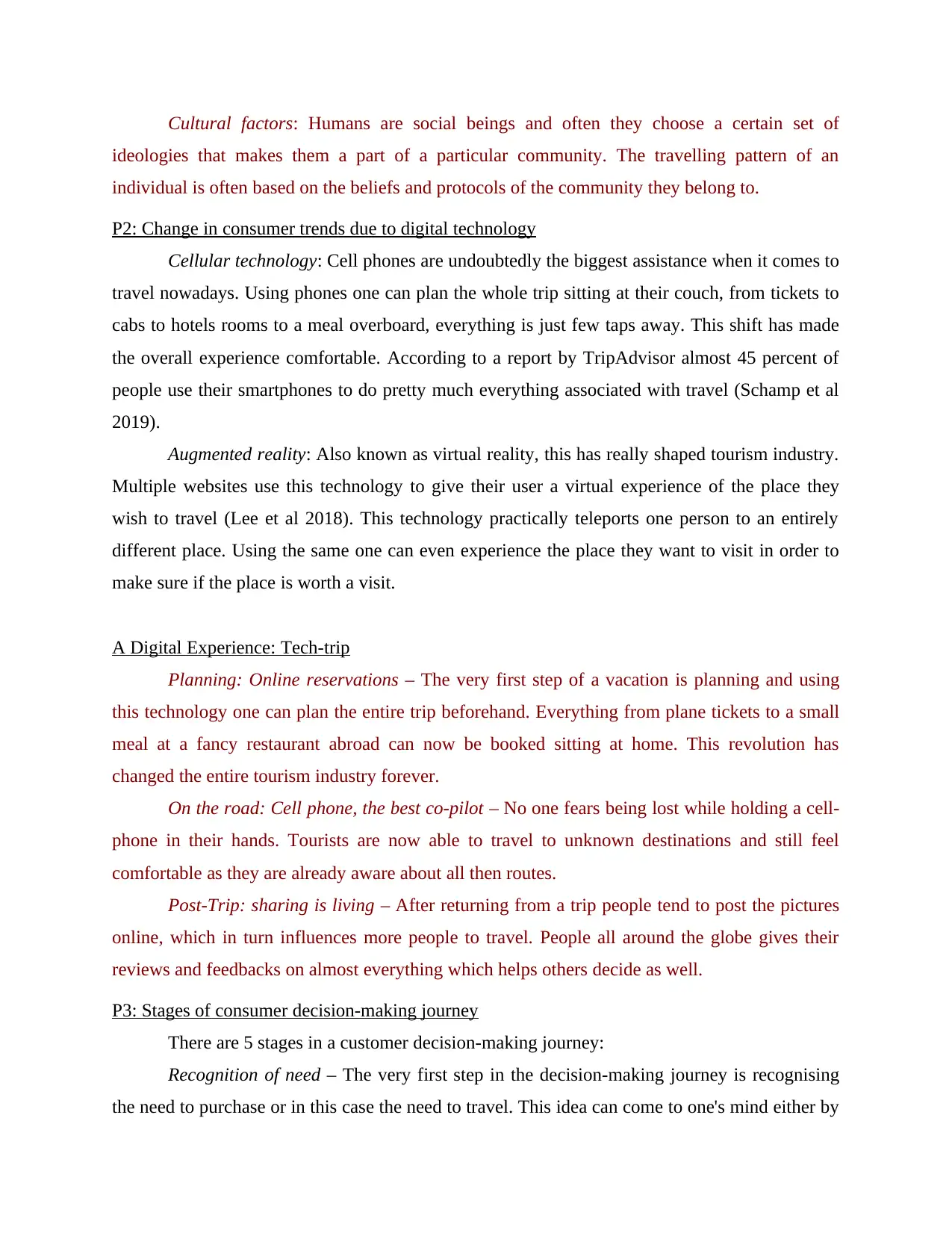
Cultural factors: Humans are social beings and often they choose a certain set of
ideologies that makes them a part of a particular community. The travelling pattern of an
individual is often based on the beliefs and protocols of the community they belong to.
P2: Change in consumer trends due to digital technology
Cellular technology: Cell phones are undoubtedly the biggest assistance when it comes to
travel nowadays. Using phones one can plan the whole trip sitting at their couch, from tickets to
cabs to hotels rooms to a meal overboard, everything is just few taps away. This shift has made
the overall experience comfortable. According to a report by TripAdvisor almost 45 percent of
people use their smartphones to do pretty much everything associated with travel (Schamp et al
2019).
Augmented reality: Also known as virtual reality, this has really shaped tourism industry.
Multiple websites use this technology to give their user a virtual experience of the place they
wish to travel (Lee et al 2018). This technology practically teleports one person to an entirely
different place. Using the same one can even experience the place they want to visit in order to
make sure if the place is worth a visit.
A Digital Experience: Tech-trip
Planning: Online reservations – The very first step of a vacation is planning and using
this technology one can plan the entire trip beforehand. Everything from plane tickets to a small
meal at a fancy restaurant abroad can now be booked sitting at home. This revolution has
changed the entire tourism industry forever.
On the road: Cell phone, the best co-pilot – No one fears being lost while holding a cell-
phone in their hands. Tourists are now able to travel to unknown destinations and still feel
comfortable as they are already aware about all then routes.
Post-Trip: sharing is living – After returning from a trip people tend to post the pictures
online, which in turn influences more people to travel. People all around the globe gives their
reviews and feedbacks on almost everything which helps others decide as well.
P3: Stages of consumer decision-making journey
There are 5 stages in a customer decision-making journey:
Recognition of need – The very first step in the decision-making journey is recognising
the need to purchase or in this case the need to travel. This idea can come to one's mind either by
ideologies that makes them a part of a particular community. The travelling pattern of an
individual is often based on the beliefs and protocols of the community they belong to.
P2: Change in consumer trends due to digital technology
Cellular technology: Cell phones are undoubtedly the biggest assistance when it comes to
travel nowadays. Using phones one can plan the whole trip sitting at their couch, from tickets to
cabs to hotels rooms to a meal overboard, everything is just few taps away. This shift has made
the overall experience comfortable. According to a report by TripAdvisor almost 45 percent of
people use their smartphones to do pretty much everything associated with travel (Schamp et al
2019).
Augmented reality: Also known as virtual reality, this has really shaped tourism industry.
Multiple websites use this technology to give their user a virtual experience of the place they
wish to travel (Lee et al 2018). This technology practically teleports one person to an entirely
different place. Using the same one can even experience the place they want to visit in order to
make sure if the place is worth a visit.
A Digital Experience: Tech-trip
Planning: Online reservations – The very first step of a vacation is planning and using
this technology one can plan the entire trip beforehand. Everything from plane tickets to a small
meal at a fancy restaurant abroad can now be booked sitting at home. This revolution has
changed the entire tourism industry forever.
On the road: Cell phone, the best co-pilot – No one fears being lost while holding a cell-
phone in their hands. Tourists are now able to travel to unknown destinations and still feel
comfortable as they are already aware about all then routes.
Post-Trip: sharing is living – After returning from a trip people tend to post the pictures
online, which in turn influences more people to travel. People all around the globe gives their
reviews and feedbacks on almost everything which helps others decide as well.
P3: Stages of consumer decision-making journey
There are 5 stages in a customer decision-making journey:
Recognition of need – The very first step in the decision-making journey is recognising
the need to purchase or in this case the need to travel. This idea can come to one's mind either by
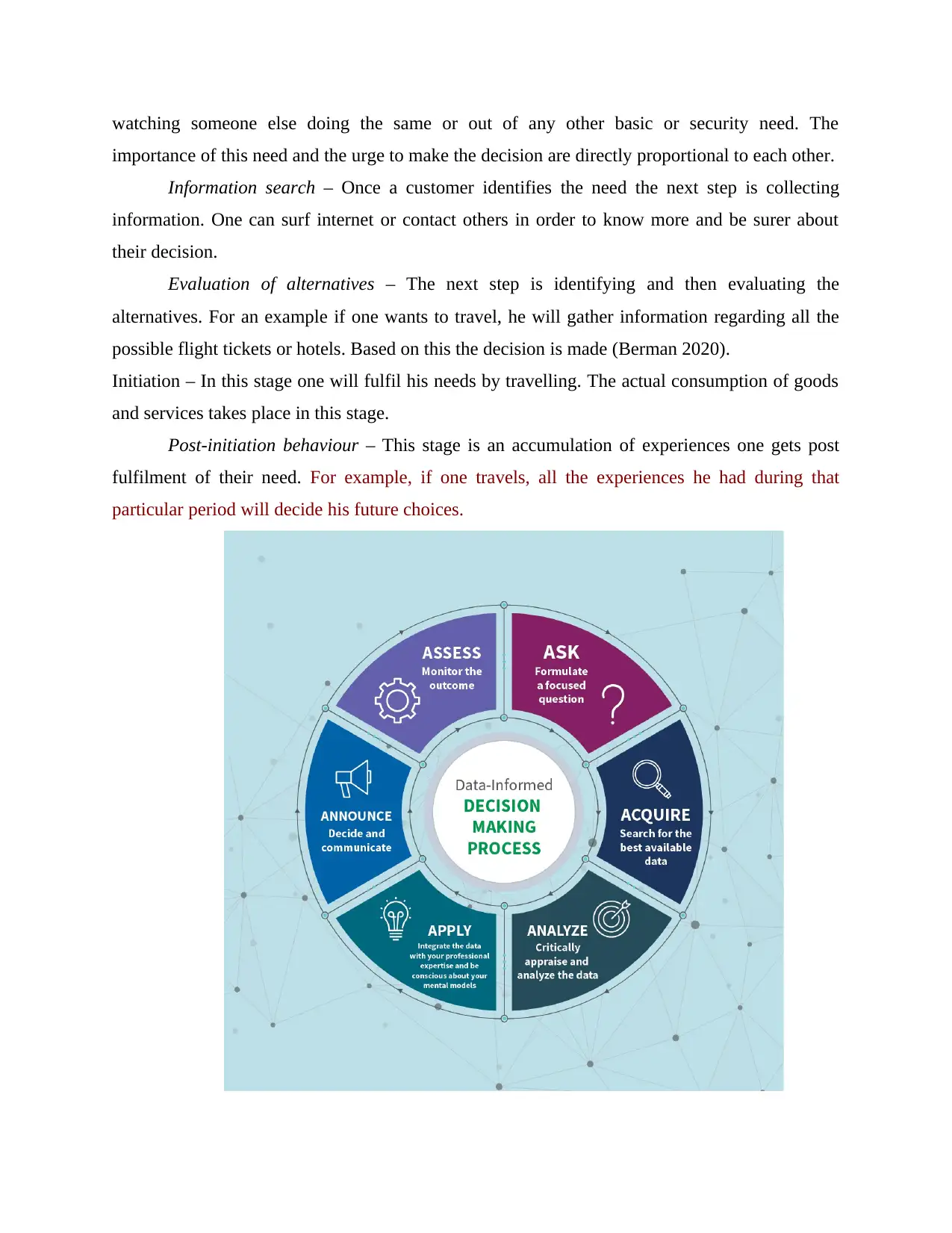
watching someone else doing the same or out of any other basic or security need. The
importance of this need and the urge to make the decision are directly proportional to each other.
Information search – Once a customer identifies the need the next step is collecting
information. One can surf internet or contact others in order to know more and be surer about
their decision.
Evaluation of alternatives – The next step is identifying and then evaluating the
alternatives. For an example if one wants to travel, he will gather information regarding all the
possible flight tickets or hotels. Based on this the decision is made (Berman 2020).
Initiation – In this stage one will fulfil his needs by travelling. The actual consumption of goods
and services takes place in this stage.
Post-initiation behaviour – This stage is an accumulation of experiences one gets post
fulfilment of their need. For example, if one travels, all the experiences he had during that
particular period will decide his future choices.
importance of this need and the urge to make the decision are directly proportional to each other.
Information search – Once a customer identifies the need the next step is collecting
information. One can surf internet or contact others in order to know more and be surer about
their decision.
Evaluation of alternatives – The next step is identifying and then evaluating the
alternatives. For an example if one wants to travel, he will gather information regarding all the
possible flight tickets or hotels. Based on this the decision is made (Berman 2020).
Initiation – In this stage one will fulfil his needs by travelling. The actual consumption of goods
and services takes place in this stage.
Post-initiation behaviour – This stage is an accumulation of experiences one gets post
fulfilment of their need. For example, if one travels, all the experiences he had during that
particular period will decide his future choices.
⊘ This is a preview!⊘
Do you want full access?
Subscribe today to unlock all pages.

Trusted by 1+ million students worldwide
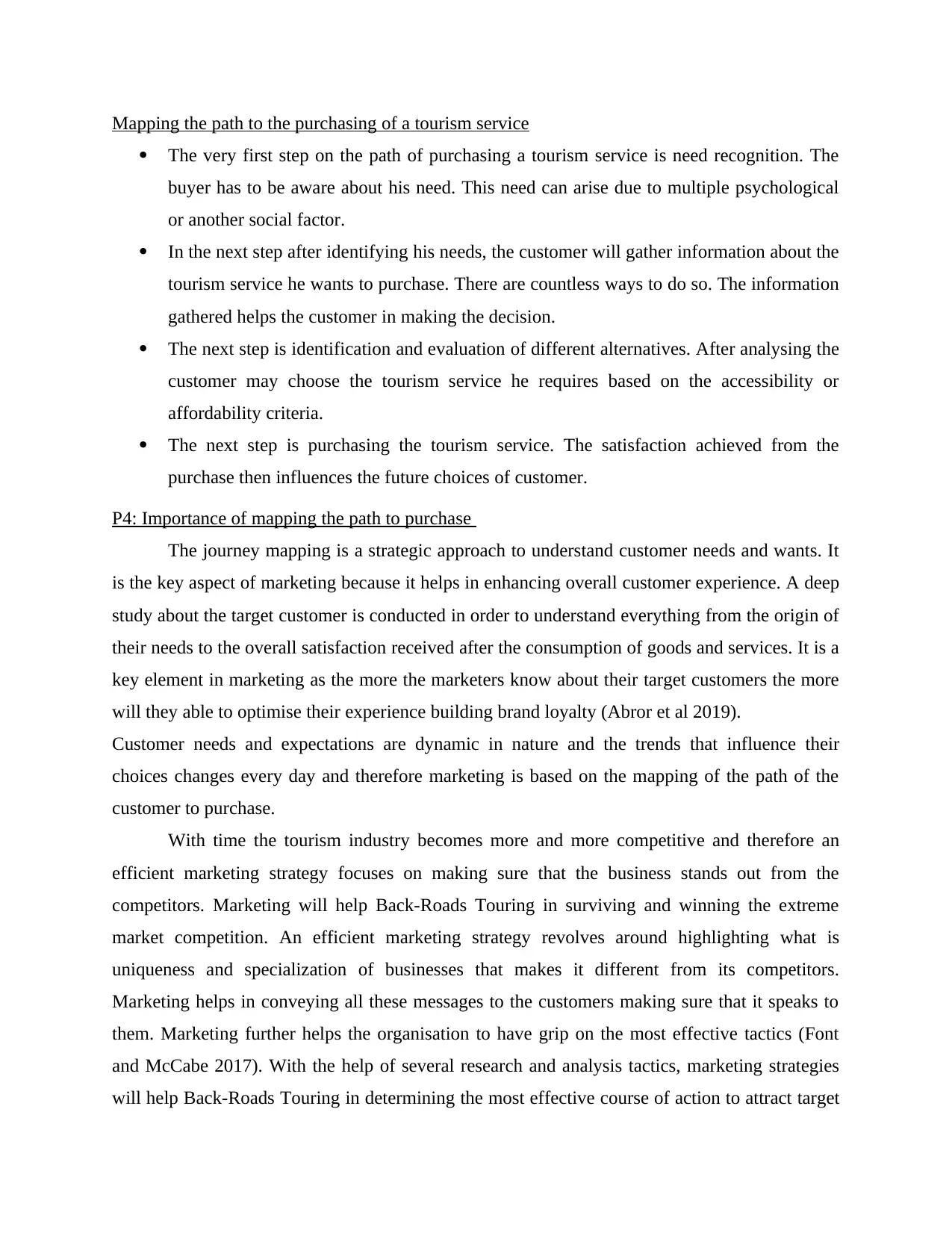
Mapping the path to the purchasing of a tourism service
The very first step on the path of purchasing a tourism service is need recognition. The
buyer has to be aware about his need. This need can arise due to multiple psychological
or another social factor.
In the next step after identifying his needs, the customer will gather information about the
tourism service he wants to purchase. There are countless ways to do so. The information
gathered helps the customer in making the decision.
The next step is identification and evaluation of different alternatives. After analysing the
customer may choose the tourism service he requires based on the accessibility or
affordability criteria.
The next step is purchasing the tourism service. The satisfaction achieved from the
purchase then influences the future choices of customer.
P4: Importance of mapping the path to purchase
The journey mapping is a strategic approach to understand customer needs and wants. It
is the key aspect of marketing because it helps in enhancing overall customer experience. A deep
study about the target customer is conducted in order to understand everything from the origin of
their needs to the overall satisfaction received after the consumption of goods and services. It is a
key element in marketing as the more the marketers know about their target customers the more
will they able to optimise their experience building brand loyalty (Abror et al 2019).
Customer needs and expectations are dynamic in nature and the trends that influence their
choices changes every day and therefore marketing is based on the mapping of the path of the
customer to purchase.
With time the tourism industry becomes more and more competitive and therefore an
efficient marketing strategy focuses on making sure that the business stands out from the
competitors. Marketing will help Back-Roads Touring in surviving and winning the extreme
market competition. An efficient marketing strategy revolves around highlighting what is
uniqueness and specialization of businesses that makes it different from its competitors.
Marketing helps in conveying all these messages to the customers making sure that it speaks to
them. Marketing further helps the organisation to have grip on the most effective tactics (Font
and McCabe 2017). With the help of several research and analysis tactics, marketing strategies
will help Back-Roads Touring in determining the most effective course of action to attract target
The very first step on the path of purchasing a tourism service is need recognition. The
buyer has to be aware about his need. This need can arise due to multiple psychological
or another social factor.
In the next step after identifying his needs, the customer will gather information about the
tourism service he wants to purchase. There are countless ways to do so. The information
gathered helps the customer in making the decision.
The next step is identification and evaluation of different alternatives. After analysing the
customer may choose the tourism service he requires based on the accessibility or
affordability criteria.
The next step is purchasing the tourism service. The satisfaction achieved from the
purchase then influences the future choices of customer.
P4: Importance of mapping the path to purchase
The journey mapping is a strategic approach to understand customer needs and wants. It
is the key aspect of marketing because it helps in enhancing overall customer experience. A deep
study about the target customer is conducted in order to understand everything from the origin of
their needs to the overall satisfaction received after the consumption of goods and services. It is a
key element in marketing as the more the marketers know about their target customers the more
will they able to optimise their experience building brand loyalty (Abror et al 2019).
Customer needs and expectations are dynamic in nature and the trends that influence their
choices changes every day and therefore marketing is based on the mapping of the path of the
customer to purchase.
With time the tourism industry becomes more and more competitive and therefore an
efficient marketing strategy focuses on making sure that the business stands out from the
competitors. Marketing will help Back-Roads Touring in surviving and winning the extreme
market competition. An efficient marketing strategy revolves around highlighting what is
uniqueness and specialization of businesses that makes it different from its competitors.
Marketing helps in conveying all these messages to the customers making sure that it speaks to
them. Marketing further helps the organisation to have grip on the most effective tactics (Font
and McCabe 2017). With the help of several research and analysis tactics, marketing strategies
will help Back-Roads Touring in determining the most effective course of action to attract target
Paraphrase This Document
Need a fresh take? Get an instant paraphrase of this document with our AI Paraphraser
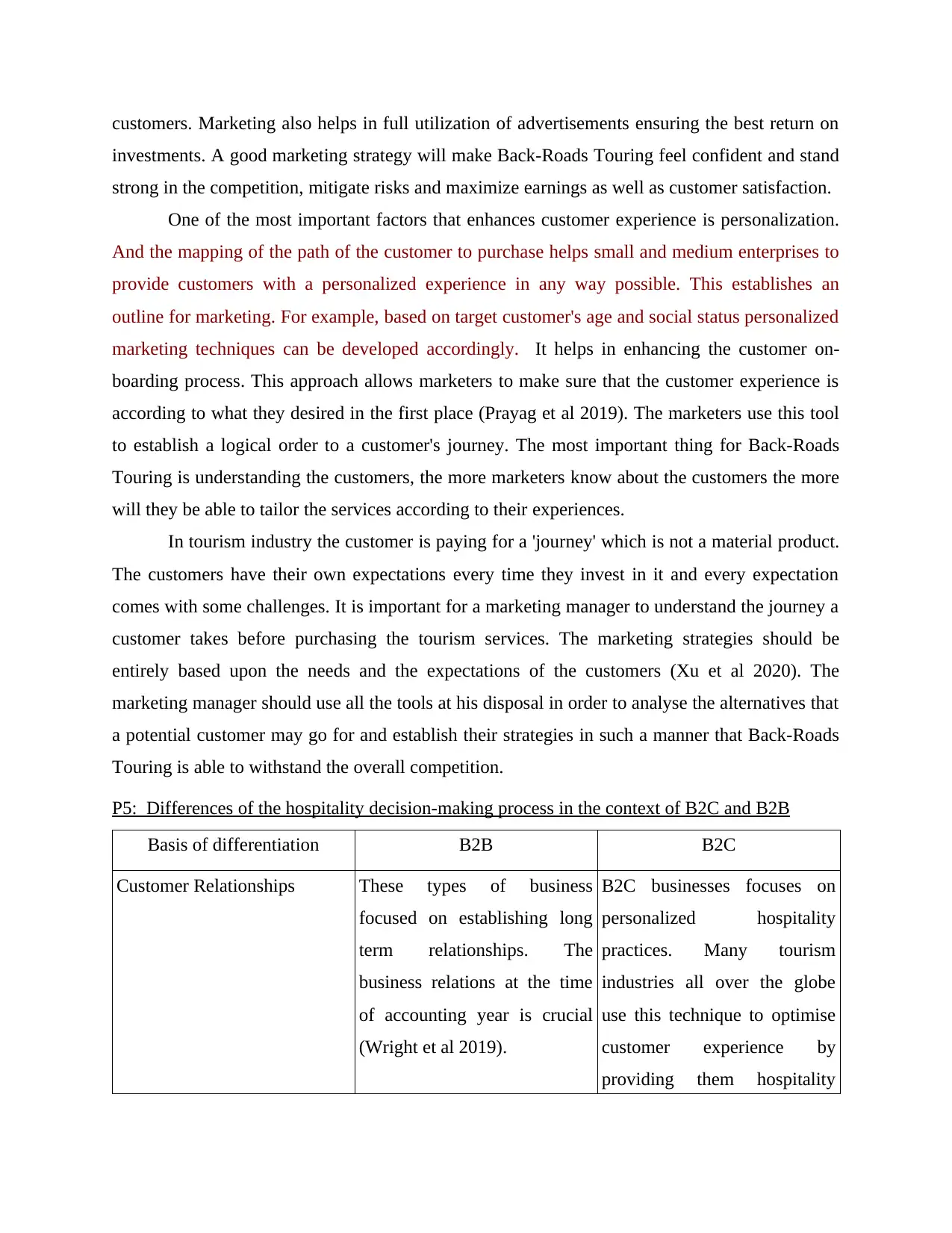
customers. Marketing also helps in full utilization of advertisements ensuring the best return on
investments. A good marketing strategy will make Back-Roads Touring feel confident and stand
strong in the competition, mitigate risks and maximize earnings as well as customer satisfaction.
One of the most important factors that enhances customer experience is personalization.
And the mapping of the path of the customer to purchase helps small and medium enterprises to
provide customers with a personalized experience in any way possible. This establishes an
outline for marketing. For example, based on target customer's age and social status personalized
marketing techniques can be developed accordingly. It helps in enhancing the customer on-
boarding process. This approach allows marketers to make sure that the customer experience is
according to what they desired in the first place (Prayag et al 2019). The marketers use this tool
to establish a logical order to a customer's journey. The most important thing for Back-Roads
Touring is understanding the customers, the more marketers know about the customers the more
will they be able to tailor the services according to their experiences.
In tourism industry the customer is paying for a 'journey' which is not a material product.
The customers have their own expectations every time they invest in it and every expectation
comes with some challenges. It is important for a marketing manager to understand the journey a
customer takes before purchasing the tourism services. The marketing strategies should be
entirely based upon the needs and the expectations of the customers (Xu et al 2020). The
marketing manager should use all the tools at his disposal in order to analyse the alternatives that
a potential customer may go for and establish their strategies in such a manner that Back-Roads
Touring is able to withstand the overall competition.
P5: Differences of the hospitality decision-making process in the context of B2C and B2B
Basis of differentiation B2B B2C
Customer Relationships These types of business
focused on establishing long
term relationships. The
business relations at the time
of accounting year is crucial
(Wright et al 2019).
B2C businesses focuses on
personalized hospitality
practices. Many tourism
industries all over the globe
use this technique to optimise
customer experience by
providing them hospitality
investments. A good marketing strategy will make Back-Roads Touring feel confident and stand
strong in the competition, mitigate risks and maximize earnings as well as customer satisfaction.
One of the most important factors that enhances customer experience is personalization.
And the mapping of the path of the customer to purchase helps small and medium enterprises to
provide customers with a personalized experience in any way possible. This establishes an
outline for marketing. For example, based on target customer's age and social status personalized
marketing techniques can be developed accordingly. It helps in enhancing the customer on-
boarding process. This approach allows marketers to make sure that the customer experience is
according to what they desired in the first place (Prayag et al 2019). The marketers use this tool
to establish a logical order to a customer's journey. The most important thing for Back-Roads
Touring is understanding the customers, the more marketers know about the customers the more
will they be able to tailor the services according to their experiences.
In tourism industry the customer is paying for a 'journey' which is not a material product.
The customers have their own expectations every time they invest in it and every expectation
comes with some challenges. It is important for a marketing manager to understand the journey a
customer takes before purchasing the tourism services. The marketing strategies should be
entirely based upon the needs and the expectations of the customers (Xu et al 2020). The
marketing manager should use all the tools at his disposal in order to analyse the alternatives that
a potential customer may go for and establish their strategies in such a manner that Back-Roads
Touring is able to withstand the overall competition.
P5: Differences of the hospitality decision-making process in the context of B2C and B2B
Basis of differentiation B2B B2C
Customer Relationships These types of business
focused on establishing long
term relationships. The
business relations at the time
of accounting year is crucial
(Wright et al 2019).
B2C businesses focuses on
personalized hospitality
practices. Many tourism
industries all over the globe
use this technique to optimise
customer experience by
providing them hospitality
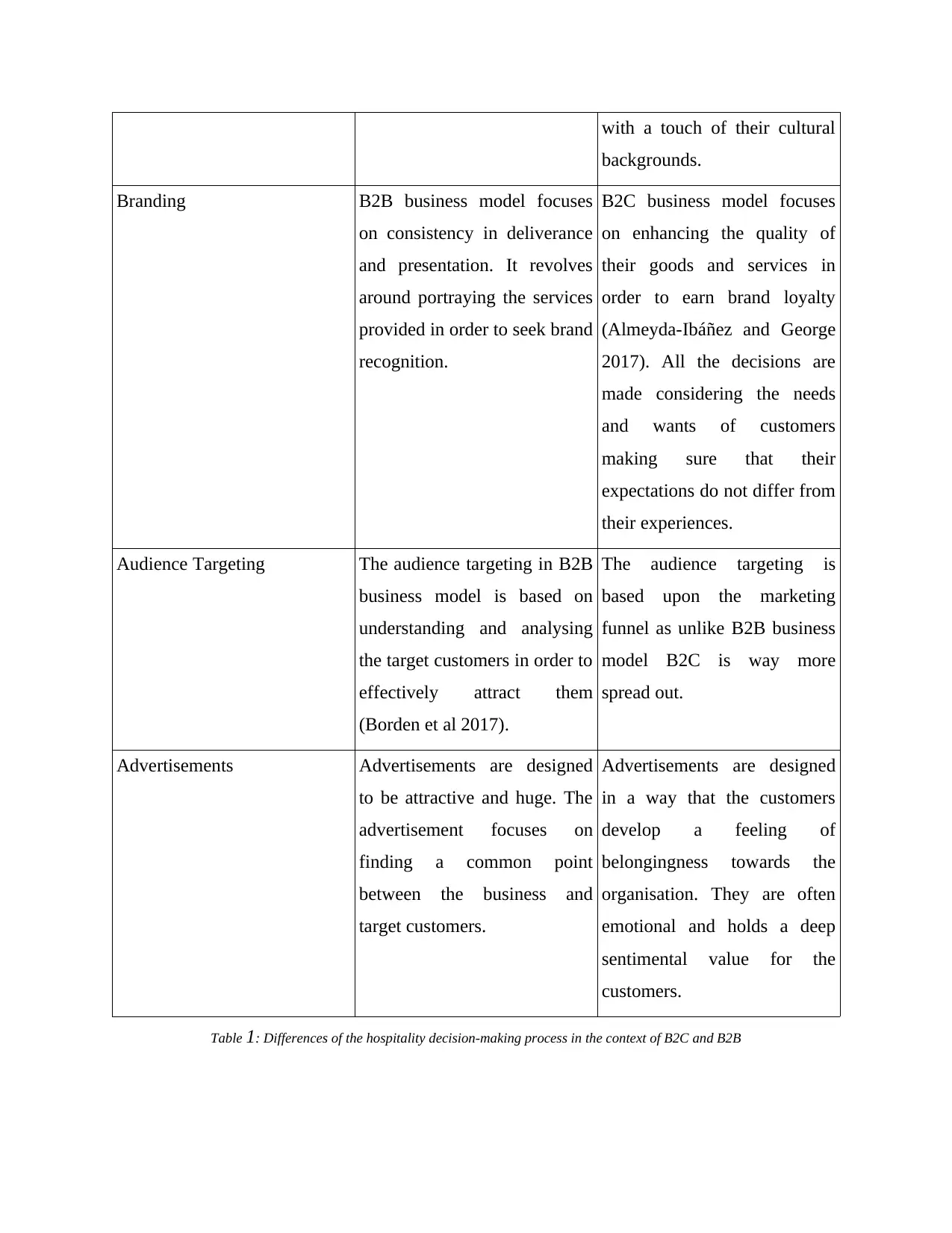
with a touch of their cultural
backgrounds.
Branding B2B business model focuses
on consistency in deliverance
and presentation. It revolves
around portraying the services
provided in order to seek brand
recognition.
B2C business model focuses
on enhancing the quality of
their goods and services in
order to earn brand loyalty
(Almeyda-Ibáñez and George
2017). All the decisions are
made considering the needs
and wants of customers
making sure that their
expectations do not differ from
their experiences.
Audience Targeting The audience targeting in B2B
business model is based on
understanding and analysing
the target customers in order to
effectively attract them
(Borden et al 2017).
The audience targeting is
based upon the marketing
funnel as unlike B2B business
model B2C is way more
spread out.
Advertisements Advertisements are designed
to be attractive and huge. The
advertisement focuses on
finding a common point
between the business and
target customers.
Advertisements are designed
in a way that the customers
develop a feeling of
belongingness towards the
organisation. They are often
emotional and holds a deep
sentimental value for the
customers.
Table 1: Differences of the hospitality decision-making process in the context of B2C and B2B
backgrounds.
Branding B2B business model focuses
on consistency in deliverance
and presentation. It revolves
around portraying the services
provided in order to seek brand
recognition.
B2C business model focuses
on enhancing the quality of
their goods and services in
order to earn brand loyalty
(Almeyda-Ibáñez and George
2017). All the decisions are
made considering the needs
and wants of customers
making sure that their
expectations do not differ from
their experiences.
Audience Targeting The audience targeting in B2B
business model is based on
understanding and analysing
the target customers in order to
effectively attract them
(Borden et al 2017).
The audience targeting is
based upon the marketing
funnel as unlike B2B business
model B2C is way more
spread out.
Advertisements Advertisements are designed
to be attractive and huge. The
advertisement focuses on
finding a common point
between the business and
target customers.
Advertisements are designed
in a way that the customers
develop a feeling of
belongingness towards the
organisation. They are often
emotional and holds a deep
sentimental value for the
customers.
Table 1: Differences of the hospitality decision-making process in the context of B2C and B2B
⊘ This is a preview!⊘
Do you want full access?
Subscribe today to unlock all pages.

Trusted by 1+ million students worldwide
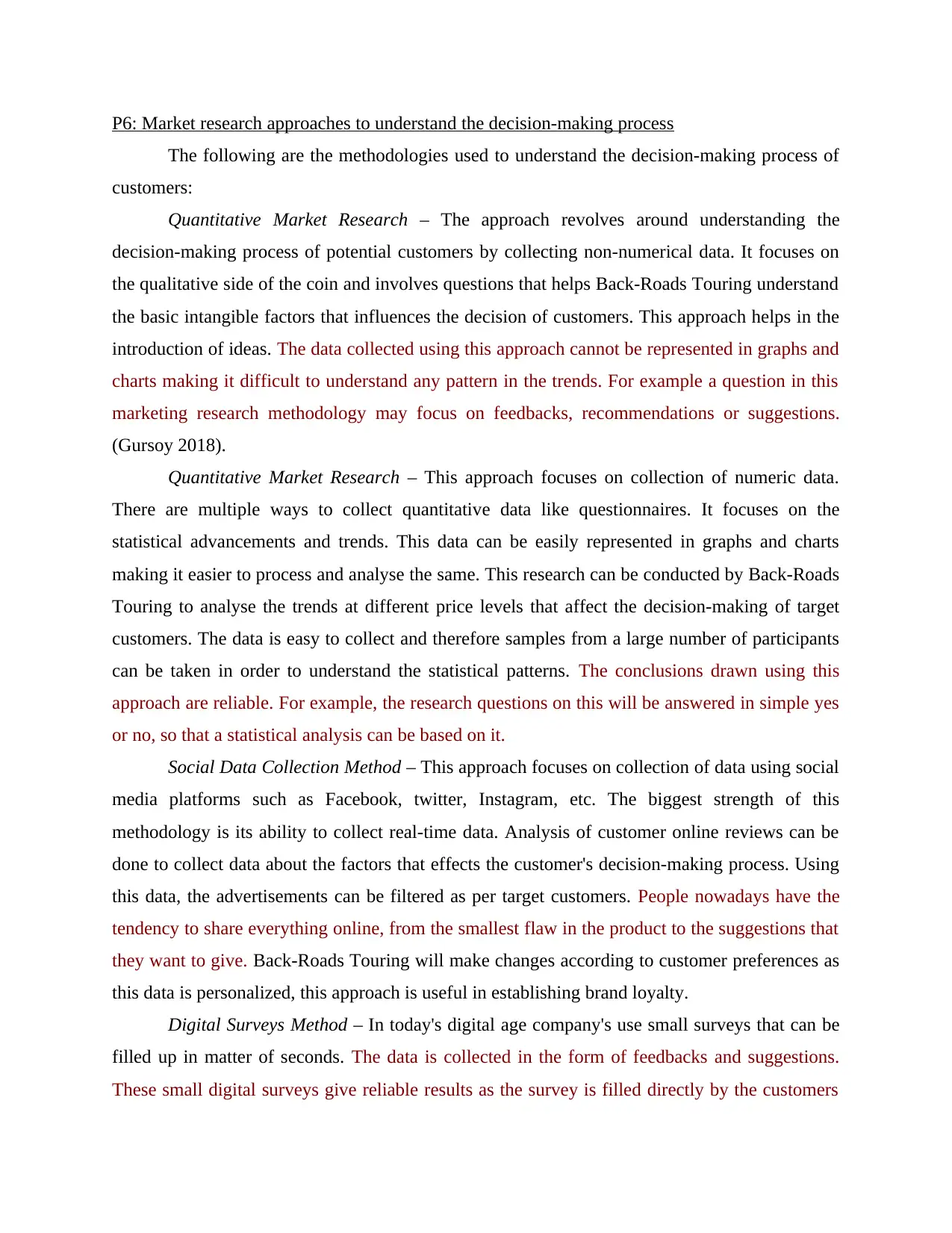
P6: Market research approaches to understand the decision-making process
The following are the methodologies used to understand the decision-making process of
customers:
Quantitative Market Research – The approach revolves around understanding the
decision-making process of potential customers by collecting non-numerical data. It focuses on
the qualitative side of the coin and involves questions that helps Back-Roads Touring understand
the basic intangible factors that influences the decision of customers. This approach helps in the
introduction of ideas. The data collected using this approach cannot be represented in graphs and
charts making it difficult to understand any pattern in the trends. For example a question in this
marketing research methodology may focus on feedbacks, recommendations or suggestions.
(Gursoy 2018).
Quantitative Market Research – This approach focuses on collection of numeric data.
There are multiple ways to collect quantitative data like questionnaires. It focuses on the
statistical advancements and trends. This data can be easily represented in graphs and charts
making it easier to process and analyse the same. This research can be conducted by Back-Roads
Touring to analyse the trends at different price levels that affect the decision-making of target
customers. The data is easy to collect and therefore samples from a large number of participants
can be taken in order to understand the statistical patterns. The conclusions drawn using this
approach are reliable. For example, the research questions on this will be answered in simple yes
or no, so that a statistical analysis can be based on it.
Social Data Collection Method – This approach focuses on collection of data using social
media platforms such as Facebook, twitter, Instagram, etc. The biggest strength of this
methodology is its ability to collect real-time data. Analysis of customer online reviews can be
done to collect data about the factors that effects the customer's decision-making process. Using
this data, the advertisements can be filtered as per target customers. People nowadays have the
tendency to share everything online, from the smallest flaw in the product to the suggestions that
they want to give. Back-Roads Touring will make changes according to customer preferences as
this data is personalized, this approach is useful in establishing brand loyalty.
Digital Surveys Method – In today's digital age company's use small surveys that can be
filled up in matter of seconds. The data is collected in the form of feedbacks and suggestions.
These small digital surveys give reliable results as the survey is filled directly by the customers
The following are the methodologies used to understand the decision-making process of
customers:
Quantitative Market Research – The approach revolves around understanding the
decision-making process of potential customers by collecting non-numerical data. It focuses on
the qualitative side of the coin and involves questions that helps Back-Roads Touring understand
the basic intangible factors that influences the decision of customers. This approach helps in the
introduction of ideas. The data collected using this approach cannot be represented in graphs and
charts making it difficult to understand any pattern in the trends. For example a question in this
marketing research methodology may focus on feedbacks, recommendations or suggestions.
(Gursoy 2018).
Quantitative Market Research – This approach focuses on collection of numeric data.
There are multiple ways to collect quantitative data like questionnaires. It focuses on the
statistical advancements and trends. This data can be easily represented in graphs and charts
making it easier to process and analyse the same. This research can be conducted by Back-Roads
Touring to analyse the trends at different price levels that affect the decision-making of target
customers. The data is easy to collect and therefore samples from a large number of participants
can be taken in order to understand the statistical patterns. The conclusions drawn using this
approach are reliable. For example, the research questions on this will be answered in simple yes
or no, so that a statistical analysis can be based on it.
Social Data Collection Method – This approach focuses on collection of data using social
media platforms such as Facebook, twitter, Instagram, etc. The biggest strength of this
methodology is its ability to collect real-time data. Analysis of customer online reviews can be
done to collect data about the factors that effects the customer's decision-making process. Using
this data, the advertisements can be filtered as per target customers. People nowadays have the
tendency to share everything online, from the smallest flaw in the product to the suggestions that
they want to give. Back-Roads Touring will make changes according to customer preferences as
this data is personalized, this approach is useful in establishing brand loyalty.
Digital Surveys Method – In today's digital age company's use small surveys that can be
filled up in matter of seconds. The data is collected in the form of feedbacks and suggestions.
These small digital surveys give reliable results as the survey is filled directly by the customers
Paraphrase This Document
Need a fresh take? Get an instant paraphrase of this document with our AI Paraphraser
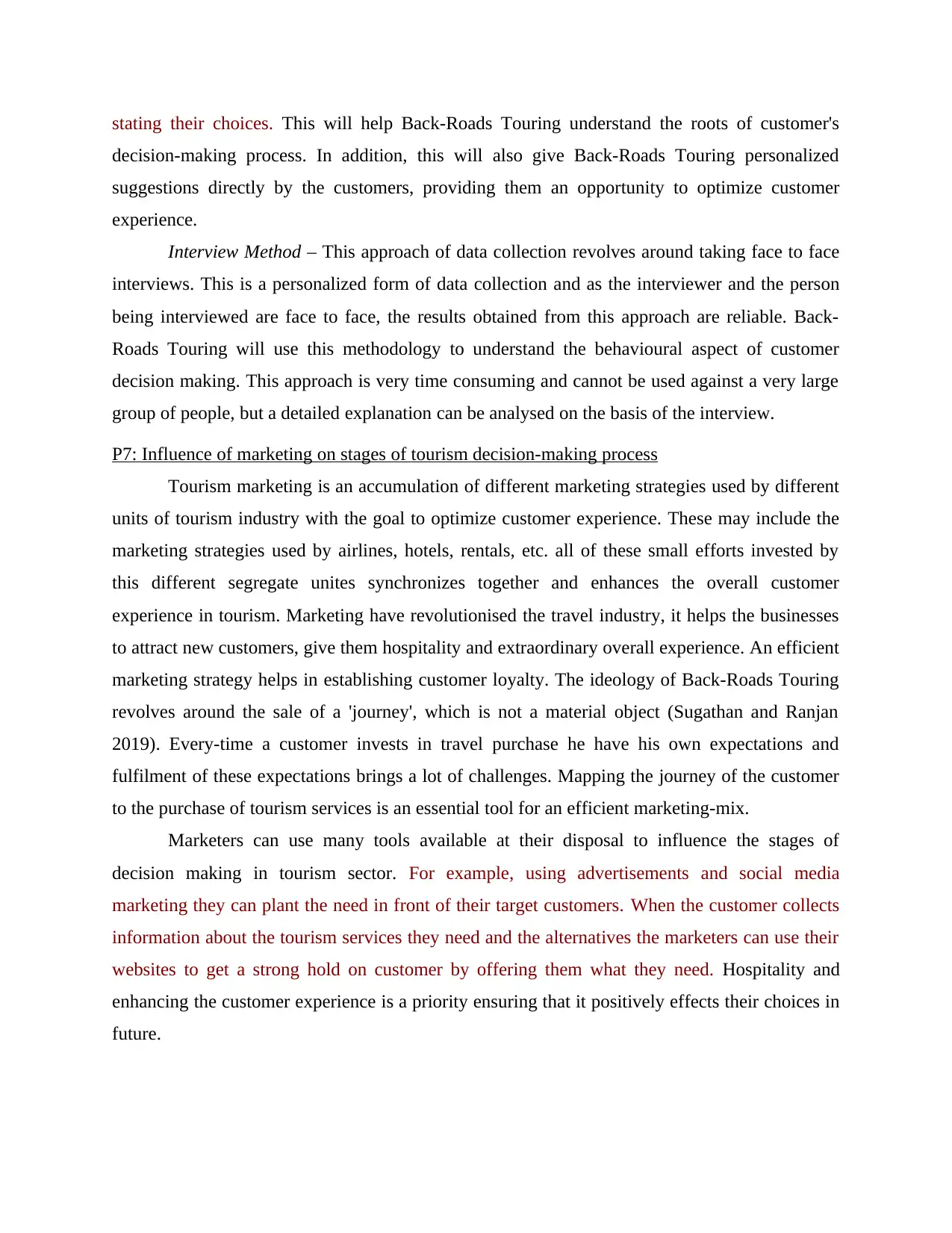
stating their choices. This will help Back-Roads Touring understand the roots of customer's
decision-making process. In addition, this will also give Back-Roads Touring personalized
suggestions directly by the customers, providing them an opportunity to optimize customer
experience.
Interview Method – This approach of data collection revolves around taking face to face
interviews. This is a personalized form of data collection and as the interviewer and the person
being interviewed are face to face, the results obtained from this approach are reliable. Back-
Roads Touring will use this methodology to understand the behavioural aspect of customer
decision making. This approach is very time consuming and cannot be used against a very large
group of people, but a detailed explanation can be analysed on the basis of the interview.
P7: Influence of marketing on stages of tourism decision-making process
Tourism marketing is an accumulation of different marketing strategies used by different
units of tourism industry with the goal to optimize customer experience. These may include the
marketing strategies used by airlines, hotels, rentals, etc. all of these small efforts invested by
this different segregate unites synchronizes together and enhances the overall customer
experience in tourism. Marketing have revolutionised the travel industry, it helps the businesses
to attract new customers, give them hospitality and extraordinary overall experience. An efficient
marketing strategy helps in establishing customer loyalty. The ideology of Back-Roads Touring
revolves around the sale of a 'journey', which is not a material object (Sugathan and Ranjan
2019). Every-time a customer invests in travel purchase he have his own expectations and
fulfilment of these expectations brings a lot of challenges. Mapping the journey of the customer
to the purchase of tourism services is an essential tool for an efficient marketing-mix.
Marketers can use many tools available at their disposal to influence the stages of
decision making in tourism sector. For example, using advertisements and social media
marketing they can plant the need in front of their target customers. When the customer collects
information about the tourism services they need and the alternatives the marketers can use their
websites to get a strong hold on customer by offering them what they need. Hospitality and
enhancing the customer experience is a priority ensuring that it positively effects their choices in
future.
decision-making process. In addition, this will also give Back-Roads Touring personalized
suggestions directly by the customers, providing them an opportunity to optimize customer
experience.
Interview Method – This approach of data collection revolves around taking face to face
interviews. This is a personalized form of data collection and as the interviewer and the person
being interviewed are face to face, the results obtained from this approach are reliable. Back-
Roads Touring will use this methodology to understand the behavioural aspect of customer
decision making. This approach is very time consuming and cannot be used against a very large
group of people, but a detailed explanation can be analysed on the basis of the interview.
P7: Influence of marketing on stages of tourism decision-making process
Tourism marketing is an accumulation of different marketing strategies used by different
units of tourism industry with the goal to optimize customer experience. These may include the
marketing strategies used by airlines, hotels, rentals, etc. all of these small efforts invested by
this different segregate unites synchronizes together and enhances the overall customer
experience in tourism. Marketing have revolutionised the travel industry, it helps the businesses
to attract new customers, give them hospitality and extraordinary overall experience. An efficient
marketing strategy helps in establishing customer loyalty. The ideology of Back-Roads Touring
revolves around the sale of a 'journey', which is not a material object (Sugathan and Ranjan
2019). Every-time a customer invests in travel purchase he have his own expectations and
fulfilment of these expectations brings a lot of challenges. Mapping the journey of the customer
to the purchase of tourism services is an essential tool for an efficient marketing-mix.
Marketers can use many tools available at their disposal to influence the stages of
decision making in tourism sector. For example, using advertisements and social media
marketing they can plant the need in front of their target customers. When the customer collects
information about the tourism services they need and the alternatives the marketers can use their
websites to get a strong hold on customer by offering them what they need. Hospitality and
enhancing the customer experience is a priority ensuring that it positively effects their choices in
future.
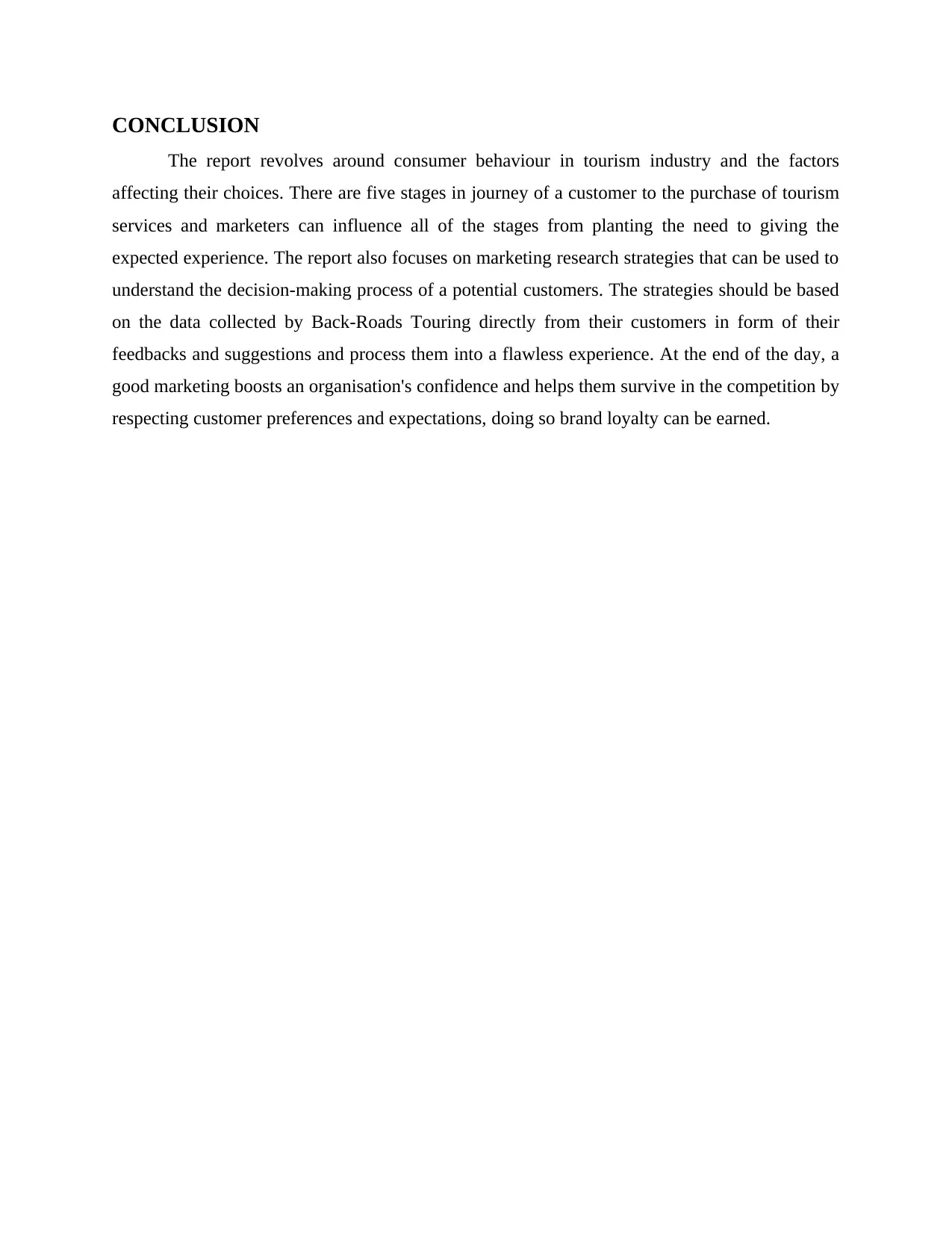
CONCLUSION
The report revolves around consumer behaviour in tourism industry and the factors
affecting their choices. There are five stages in journey of a customer to the purchase of tourism
services and marketers can influence all of the stages from planting the need to giving the
expected experience. The report also focuses on marketing research strategies that can be used to
understand the decision-making process of a potential customers. The strategies should be based
on the data collected by Back-Roads Touring directly from their customers in form of their
feedbacks and suggestions and process them into a flawless experience. At the end of the day, a
good marketing boosts an organisation's confidence and helps them survive in the competition by
respecting customer preferences and expectations, doing so brand loyalty can be earned.
The report revolves around consumer behaviour in tourism industry and the factors
affecting their choices. There are five stages in journey of a customer to the purchase of tourism
services and marketers can influence all of the stages from planting the need to giving the
expected experience. The report also focuses on marketing research strategies that can be used to
understand the decision-making process of a potential customers. The strategies should be based
on the data collected by Back-Roads Touring directly from their customers in form of their
feedbacks and suggestions and process them into a flawless experience. At the end of the day, a
good marketing boosts an organisation's confidence and helps them survive in the competition by
respecting customer preferences and expectations, doing so brand loyalty can be earned.
⊘ This is a preview!⊘
Do you want full access?
Subscribe today to unlock all pages.

Trusted by 1+ million students worldwide
1 out of 14
Related Documents
Your All-in-One AI-Powered Toolkit for Academic Success.
+13062052269
info@desklib.com
Available 24*7 on WhatsApp / Email
![[object Object]](/_next/static/media/star-bottom.7253800d.svg)
Unlock your academic potential
Copyright © 2020–2025 A2Z Services. All Rights Reserved. Developed and managed by ZUCOL.





